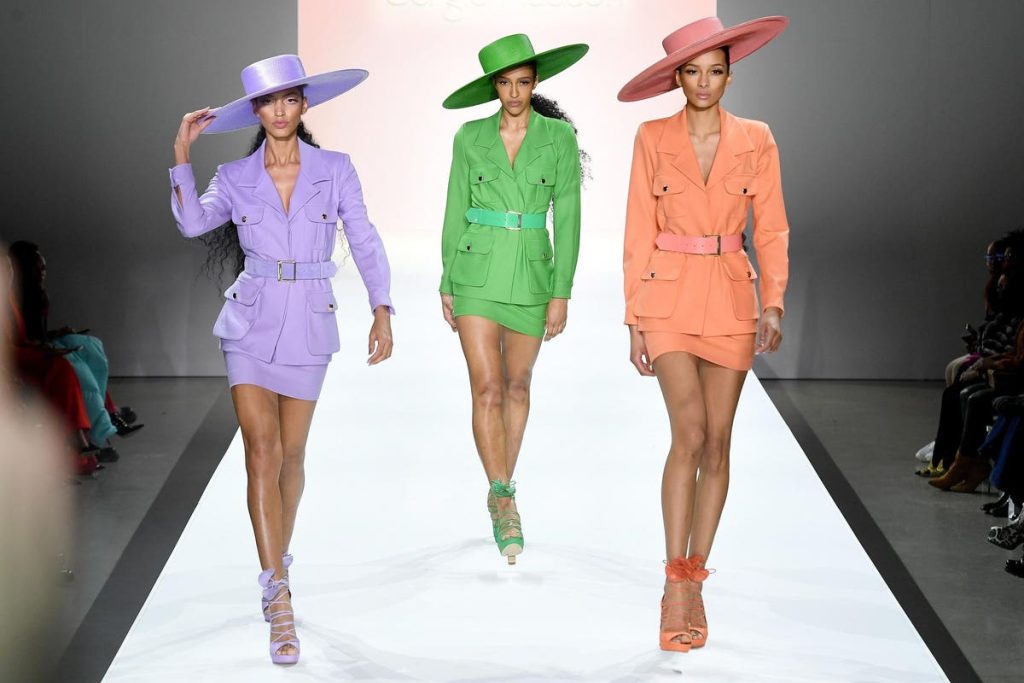We read fashion magazines, follow fashion trends, try to look like fashion models, and buy the clothes and makeup the fashion industry promotes with their powerful storytelling. But “the equivalent of one garbage truck full of clothes is burned or dumped in a landfill every second,” according to the United Nations Environmental Programme. They also reported that the fashion industry produces between 8% and 10% of global carbon emissions, which is more than all international flights and maritime shipping combined – and uses about 93 billion cubic meters of water each year, “contributing significantly to water scarcity in some regions.” Not to mention the microfibers polluting our waters.
All because we choose to buy more and more new clothes every year, every season, every month.
“But these are also industries that have an incredible gift and a ton of experience in telling stories that inspire us,” Allure magazine beauty editor Jenny Bailly said at the UN SDG Media Zone last week. The SDG Media Zone was held during the 2023 annual UN General Assembly and is facilitated in part by the Conscious Fashion Campaign, whose CEO and Cofounder is Kerry Bannigan, during Climate Week 2023.
What would happen if the powerful fashion marketing and media machines turned their “gift” and storytelling skills to persuading consumers to, well, buy less clothing and wear what they have for longer? What if the creative fashion designers and manufacturers found ways to dramatically reduce their carbon emissions, water and energy use and the waste they generate?
How to do that was the focus of Bailly’s panel on fashion and the Sustainable Development Goals (SDGs).
Bailly’s panelists came from different sides of the industry: Isabelle Marras is Senior Programme Officer, Interagency Affairs at the UN Environmental Programme, whose team developed the newly released Sustainable Fashion Communication Playbook, to help the industry “align consumer-facing communication across the global fashion industry with sustainability targets.” Aileen Lerch is Sustainability Senior Manager at shoe manufacturer Allbirds. Aditi Mayer is a National Geographic digital storytelling fellow focused on sustainable fashion.
Here are six ways Bailly, Marras, Lerch and Mayer said fashion creatives can help reduce the environmental impact of what we wear:
· Be transparent: Disclose the origin of the fibers in the clothing, where the manufacturing takes place, who makes them and how they are paid, the environmental impact of the clothing, and how to maintain and dispose of the item sustainably. Lerch said Allbirds labels all their products with that product’s carbon footprint.
· Change the narrative from consumption and disposability – including “fast fashion” – to sustainability, reuse and responsibility: The UNEP’s Sustainable Fashion Communications Playbook specifically focuses on helping fashion marketers and media do this by: “1) countering misinformation and greenwashing, 2) reducing messages perpetuating overconsumption, 3) redirecting aspiration to more sustainable lifestyles, and 4) empowering consumers in their role as citizens to demand greater action from businesses and policymakers.”
· Support greater regulation of the fashion industry: Lerch and Marras in particular mentioned the opportunity for policymakers to provide more environmental guardrails through regulation.
· Leverage their storytelling skills to encourage consumers to adopt sustainable fashion habits – and to demand more sustainable products: This was the primary emphasis of the panel, because the industry’s marketing and media are so influential. “I try to showcase narratives around personal style that goes beyond trend culture,” Mayer explained. “I really try to focus on using the resources we have. So, it’s about styling, upcycling and mending. And I think this speaks to the shift from consumption to creativity.”
· Use their platforms to pressure industry players to adopt sustainable practices: The fashion media can use its power to encourage designers, manufacturers and retailers to make and sell truly sustainable clothing and cosmetics, the panel said.
· Collaborate with other industry players to reduce the industry’s environmental impact: Ultimately, it’s the supply side that can reduce the industry’s environmental impact dramatically, so the panel talked about collaborating as one of the best ways to do that, so the whole industry transforms, not just a few designers.
“Shift the consumer mindset”
The key to making the fashion industry part of the solution instead of part of the climate problem, the panel emphasized, was the combination of transparency, accountability, and changing the consumer mindset.
The industry both follows and leads consumers, and that’s a great deal of power.
Sharing personal stories of how they personally changed their fashion habits to be more environmentally friendly and socially responsible would help too, the panelists said.
“Imagine if all of this power was redirected towards the sustainable development goals, towards sustainable lifestyles. The opportunity before us is a creative one, and all of us have a role to play in accelerating the transition towards a sustainable and circular future and fashion can help lead the way.”
That was the key message that model, actress and sustainability activist Amber Valletta – who is now the Fashion Institute of Technology’s first Sustainability Ambassador – said about the influential fashion industry’s marketing machine in a short video played at the start of the panel.
Imagine…
Read the full article here










